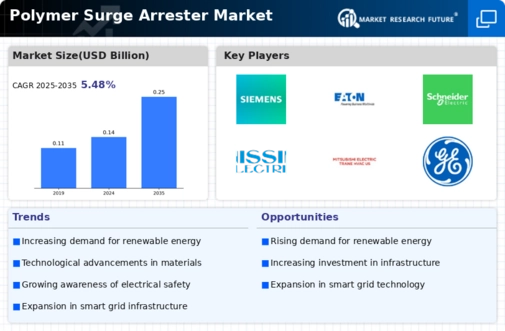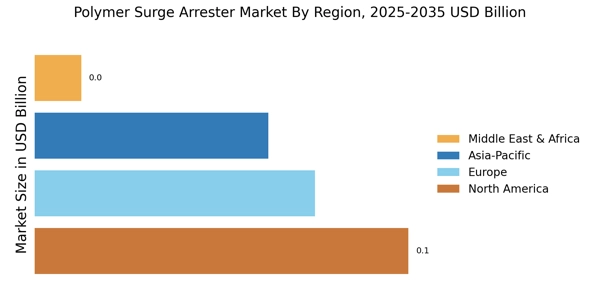Growth in Renewable Energy Projects
The Polymer Surge Arrester Market is significantly impacted by the growth in renewable energy projects worldwide. As the shift towards sustainable energy sources accelerates, the need for reliable surge protection in renewable energy installations becomes increasingly critical. Polymer surge arresters play a vital role in protecting solar panels, wind turbines, and other renewable energy systems from voltage surges. Recent statistics indicate that investments in renewable energy are expected to exceed several hundred billion dollars annually. This investment trend not only supports the expansion of renewable energy infrastructure but also drives the demand for polymer surge arresters, which are essential for ensuring the operational efficiency and longevity of these systems. Consequently, the growth of renewable energy projects presents a substantial opportunity for the polymer surge arrester market.
Rising Awareness of Electrical Safety
The Polymer Surge Arrester Market is witnessing a heightened awareness of electrical safety among consumers and businesses alike. As incidents of electrical failures and equipment damage continue to rise, stakeholders are increasingly recognizing the importance of implementing effective surge protection measures. This awareness is further fueled by regulatory bodies advocating for stringent safety standards in electrical installations. Data suggests that the market for electrical safety devices, including polymer surge arresters, is expected to grow significantly as organizations prioritize safety and compliance. The increasing focus on electrical safety not only drives demand for polymer surge arresters but also encourages manufacturers to innovate and enhance the performance of their products. As a result, the polymer surge arrester market is likely to benefit from this growing emphasis on safety and reliability.
Expansion of Electrical Infrastructure
The Polymer Surge Arrester Market is significantly influenced by the ongoing expansion of electrical infrastructure across various regions. Governments and private entities are investing heavily in upgrading and expanding power grids to meet the increasing energy demands. This expansion necessitates the integration of advanced surge protection solutions, such as polymer surge arresters, to safeguard sensitive equipment from voltage spikes. Recent reports indicate that investments in electrical infrastructure are expected to reach trillions of dollars in the coming decade. This investment trend creates a favorable environment for the polymer surge arrester market, as these devices are essential for ensuring the longevity and reliability of electrical systems. Consequently, the growth of electrical infrastructure is likely to propel the demand for polymer surge arresters, thereby enhancing market opportunities.
Increasing Demand for Reliable Power Supply
The Polymer Surge Arrester Market is experiencing a surge in demand for reliable power supply solutions. As industries and residential sectors increasingly depend on uninterrupted electricity, the need for effective surge protection becomes paramount. This demand is driven by the rising frequency of electrical disturbances and the growing complexity of electrical systems. According to recent data, the market for surge protection devices is projected to grow at a compound annual growth rate of approximately 6% over the next few years. This trend indicates a robust market potential for polymer surge arresters, which offer enhanced performance and reliability compared to traditional options. As a result, manufacturers are focusing on developing advanced polymer surge arresters that can withstand extreme conditions, thereby catering to the evolving needs of consumers.
Technological Advancements in Surge Protection
The Polymer Surge Arrester Market is being propelled by rapid technological advancements in surge protection solutions. Innovations in materials and design are leading to the development of more efficient and durable polymer surge arresters. These advancements enable manufacturers to produce devices that can withstand higher voltage levels and offer improved response times. Recent technological breakthroughs have resulted in polymer surge arresters that are not only more effective but also more cost-efficient. As a result, the market is witnessing an influx of new products that cater to diverse applications, from industrial to residential use. This trend indicates a shift towards more sophisticated surge protection solutions, which is likely to enhance the overall growth of the polymer surge arrester market in the coming years.


















Leave a Comment